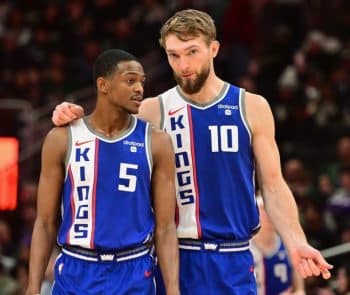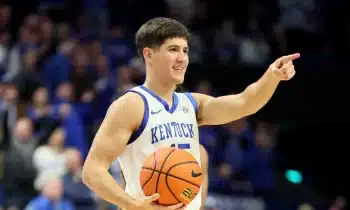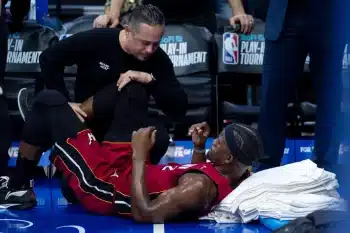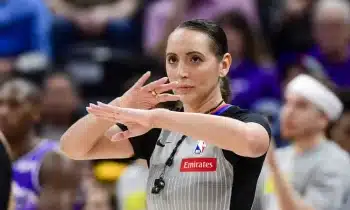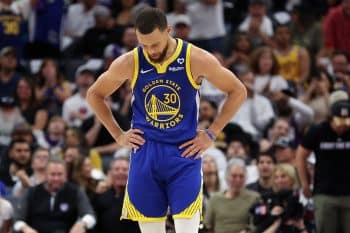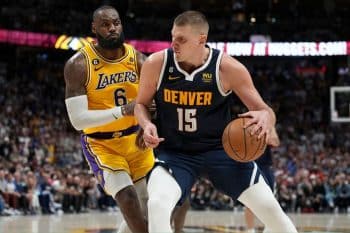NBA
NBA Rookie Extensions: Klay Thompson
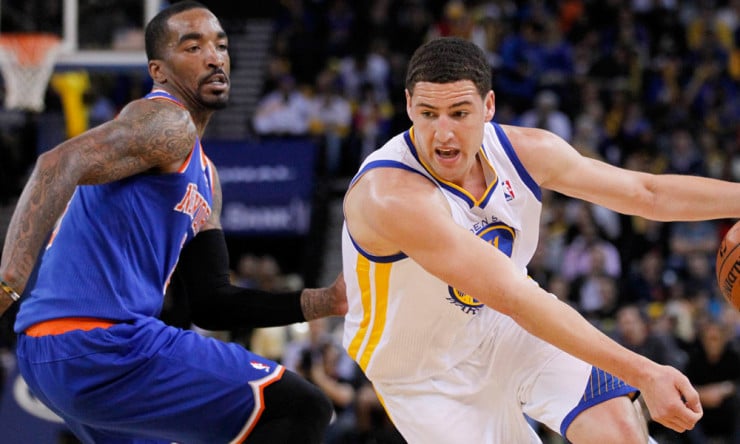
The 2014 rookie-extension class is one of the most interesting in several years due to the high number of quality players entering their fourth seasons. As most readers likely know by now, teams have until October 31 to reach extensions with first-rounders entering their fourth season or the players become restricted free agents next summer. This year, many of these players fall into the fascinating middle ground between total busts and obvious max outs, and their negotiations are further complicated by the unknown effect of the league’s recently-announced new TV deal.*
Due to the rising cap, it is useful to think of new deals in percentage terms. For example, a $10 million contract under the $58.044 million cap in 2012-13 was 17.2 percent of the cap. For the 2016-17 season, assuming the cap is $80 million for that year, an equivalent contract would be $13.8 million.
Klay Thompson
Age: 24 (February 8th, 1990)
Draft Position: 11th
2013-14 PER: 14.32
2013-14 ORPM: 2.20
2013-14 DRPM:-0.17
2015-16 Cap Hold: $7,689,700
Thompson’s negotiations have some similarities to Kawhi Leonard’s, which we covered in this space last week. With the maximum deals in restricted free agency for Gordon Hayward and Chandler Parsons this year, the market is seemingly set for Thompson next summer if he is not extended. Most would probably consider Thompson the superior player to Hayward or Parsons due to his deadeye shooting and superior defense. While there is a reasonable argument that Thompson is not worth a maximum extension in a vacuum, the market clearly thinks that he is. Moreover, both sides know that Warriors have essentially committed to him and have no way to replace him since they will very likely be capped out. The Warriors famously retained Thompson rather than trade him for Kevin Love, and his star continued to rise with an outstanding performance at the World Cup.
Thus Thompson is a cut above Hayward and Parsons on the market. That may sound like one of them good problems, but in reality it may make gleaning an offer more difficult since competing teams know there is almost no chance the deal will not be matched. In fact, the Warriors may welcome a traditional four-year max offer sheet because it would limit the contract to only 4.5% annual raises. Throw in the fact that the Warriors could avoid having to take on the risk of an injury or failure to improve this season, and they would seem to have little motivation to extend Thompson early unless he offers them a bit of a discount.
Like most restricted free agents, Thompson has little leverage to force a maximum extension now. Clearly a five-year designated player deal has not yet been offered, as he would take that in a second.* One would imagine he’d have bitten on a four-year maximum deal as well. Without such an offer Bill Duffy, Thompson’s agent, has been pulling out as many arguments as he can. Marc Stein has already reported that Thompson could sign a Parsons style three-year offer sheet with a third-year player option. Such a pact would raise the unpalatable prospect of Thompson and Stephen Curry reaching free agency simultaneously in the summer of 2017. But again it is unclear if any team would bother with such an offer knowing Golden State would surely match. Nevertheless, this is a fear for Golden State– Parsons, Dan Fegan and Mark Cuban did all restricted free agents a huge favor by pioneering that sort of deal as a way to provide at least some modicum of leverage.
Threatening to take the qualifying offer next summer is another potential way to create leverage. But it is an idle threat unless Thompson truly has reservations about playing for Golden State long-term. Playing through his fifth year without an extension just doesn’t make sense otherwise, considering Thompson would be taking on two years’ worth of risk of performance decline or injury while sacrificing an eight-figure salary in the fifth year for the piddling qualifying offer.
Aside from the risk of a Parsons-style offer, Thompson is just going to be dependent upon the Warriors’ largesse if he wants a maximum extension. While extending Thompson now and keeping him happy may have some nebulous benefits in eliminating distractions, the Warriors’ cap and tax situation makes them more likely to hold out than people might think.
If Thompson were given a maximum extension now, the Warriors would be right at the luxury tax next summer before accounting for key restricted free agent Draymond Green’s new contract. Green is an extremely underrated contributor as a burgeoning stretch four with a nice passing eye and the ability to guard all five positions in a pinch. With the amount of cap room around the league and the cap set to explode in 2016, Green could receive an offer starting as high as $8 million per year in restricted free agency. If the Warriors max out Thompson and retain Green on such a deal, they would be deep into the luxury tax.
That is over $14 million in luxury tax payments for 2015-16 assuming a $67 million cap, which is the league’s most recent estimate. Sure the tax may not be so bad for the Warriors; the tax level could rise more than projected, Green may not cost as much, salaries could be dumped. But keep in mind that is before the Warriors make any additions via the tax-payer mid-level exception or veterans’ minimum, or address restricted free agent Ognjen Kuzmic. Once they exceed $10 million over the tax, the Warriors would be paying an additional $2.50 per every $1.00 of salary added. Moreover, as a tax team the Warriors could not engage in any sign-and-trades. Warriors’ ownership has never completely ruled out paying the tax, but $14 million or more might be a lot to swallow even with the potential for a new TV deal after the 2014-15 season.*
What’s worse, re-signing Thompson and Green might make it difficult to add to the team even in the vaunted summer of 2016. That year, David Lee comes off the books and the cap should rise to at least $80 million. But the Warriors would be scheduled for at least $69 million in salaries committed, plus cap holds, another first-rounder, and anyone signed in the 2015 offseason. With Andrew Bogut, Andre Iguodala and Lee aging quickly, the Warriors will want to add another major player, likely a power forward. It seems unlikely they will have the space to do so unless the cap goes up all at once into the high $80 millions with no “smoothing.” If it becomes clear after this year that the current core cannot compete for a championship, the Warriors will have few mechanisms to improve until the summer of 2017. And if the Warriors have stagnated by then, the possibility of Curry leaving for a potentially better team becomes all too real.
All of this means that every penny will count for the Warriors with Thompson’s extension. If they can get him under contract for even just $2 million less each year or get lower annual raises by matching a contract in restricted free agency, that could be the difference in adding pieces or avoiding the tax later on. They have little impetus to agree to an extension now without some concessions by their star shooting guard.
Like the Spurs with Leonard, an even bigger reason for the Warriors to wait is Thompson’s and Green’s relatively small cap holds in the summer of 2015. The Warriors are not currently slated to have any cap room next summer even without new contracts for those two, but that could change if management gets aggressive. Golden State could potentially bribe a team like the Sixers, Magic or Jazz to take Lee and Shaun Livingston, perhaps by including Harrison Barnes and future picks. Lee’s $16 million per season expires in 2016, and Livingston is only $3 million guaranteed for 2017. The going rate in the past has been a first-rounder per $10 million in salary, but as more teams amass cap room perhaps that price will go down a bit. If the Warriors jettison Lee, Livingston and Barnes next summer, they would have near maximum cap space–if they do not extend Thompson and can avoid immediate offer sheets to him and Green.
This amount could change depending on the ultimate cap level, the specific moves made, whether Nemanja Nedovic’s third-year option is exercised and a host of other factors. But the Warriors can get to the point where they can make an offer to pretty much any major free agent next summer–if they are willing to pay the heavy price to excise salary. Punting more draft assets is certainly a terrifying prospect for an organization that has already surrendered 2014 and 2017 first-rounders to the Utah Jazz to clear space for Andre Iguodala. But if management believes it can make a splash in 2015 free agency, when power forwards like LaMarcus Aldridge* or Paul Millsap (both excellent fits stylistically) might be available, they may want to pull the trigger. Other big man free agents could include Al Jefferson, Greg Monroe, David West, Thaddeus Young, Marc Gasol, Omer Asik, DeAndre Jordan and Tyson Chandler. Making a move may prove necessary if Lee declines precipitously or the current group does not appear to be a true contender.
Signing a player like Millsap or Aldridge would probably be worth giving up draft assets and Barnes if the right deal can be found. The Warriors would be fairly thin, with only their 2015 first-rounder, Green, Festus Ezeli, whomever they can sign with the $2.8 million Room Exception and minimum guys on the bench. But the top-end talent would be tremendous.
Nevertheless, this scenario is relatively unlikely despite the Warriors’ willingness to roll the dice by offloading salary with draft assets in the past. But maintaining flexibility for next summer is another motive to wait on an extension. Unless Thompson is willing to move off his demand for a maximum salary, the only real incentive the Warriors have to acquiesce now is the threat of a Parsons-style offer sheet that may not actually be forthcoming from another team. It remains to be seen whether that will be enough.


